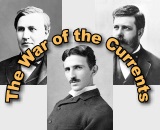 The Battle of the Currents (aka The War of the
Currents)
The Battle of the Currents (aka The War of the
Currents)
 The Battle of the Currents (aka The War of the
Currents)
The Battle of the Currents (aka The War of the
Currents)
The War of the Currents, also known as the Battle of the Currents, was a historic event in the late 19th century that pitted two prominent inventors, Thomas Edison and Nikola Tesla, against each other in a bid to establish the dominant form of electrical power transmission in the United States. At the center of this battle was the question of whether direct current (DC) or alternating current (AC) was the best way to transmit electricity over long distances.
Thomas Edison was a famous inventor, entrepreneur, and businessman who had already achieved great success with his invention of the incandescent light bulb. Edison was a staunch supporter of direct current (DC) as the most effective method for transmitting electricity. Direct current is a type of electrical current that flows in a single direction and is typically used for low voltage applications such as batteries.
On the other hand, Nikola Tesla was a Serbian-American inventor, electrical engineer, and physicist who had immigrated to the United States in the early 1880s. Tesla was an advocate of alternating current (AC) as the most effective method for transmitting electricity over long distances. Alternating current is a type of electrical current that changes direction periodically and is typically used for high voltage applications such as power grids.
The stage was set for the War of the Currents in the late 1880s when a number of companies, including Edison's General Electric, began developing electric power stations to provide electricity to homes and businesses. Edison was convinced that DC was the only way to transmit electrical power safely and efficiently, while Tesla believed that AC was the future of electrical power transmission.
In 1887, Tesla was hired by the Westinghouse Electric Company to work on the development of AC power systems. Westinghouse saw the potential of AC power and recognized Tesla's genius in this area, and so they brought him on board as a consultant.
Edison, who had a vested interest in DC power, was quick to launch a smear campaign against AC power, claiming that it was unsafe and that it posed a serious threat to public safety. Edison even went so far as to stage public demonstrations in which he electrocuted animals using AC power, in an attempt to convince the public that it was dangerous.
However, Tesla and Westinghouse continued to develop AC power, and by the early 1890s, it had become clear that AC was the future of electrical power transmission. Tesla's AC motor was a significant breakthrough in this area, as it made it possible to transmit electrical power over long distances without significant power loss.
Despite this, Edison continued to fight against AC power, and in 1893 he launched a campaign to discredit AC by introducing the electric chair as a method of execution. Edison argued that the electric chair should use AC power, claiming that it was more dangerous than DC power.
However, this backfired on Edison when an electric chair using AC power was used to execute William Kemmler in 1890. The execution was botched, and Kemmler was subjected to a prolonged and painful death, which only served to further discredit Edison's claims about the safety of AC power.
By the early 1900s, AC power had become the dominant form of electrical power transmission, and Tesla and Westinghouse had won the War of the Currents. However, the battle had taken a toll on both men, and Tesla's work on AC power had left him in poor health and financial ruin.
In conclusion, the War of the Currents was a significant event in the history of electrical power transmission, and it pitted two of the most brilliant minds of the late 19th century against each other in a battle for supremacy. Despite Edison's best efforts, AC power emerged as the clear winner, and it remains the dominant form of electrical power